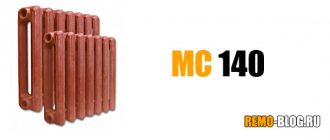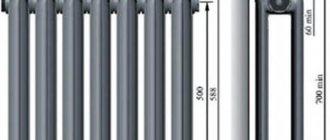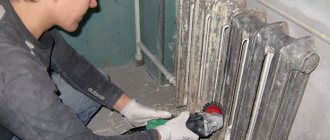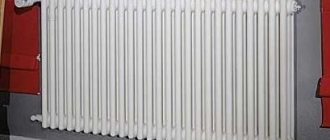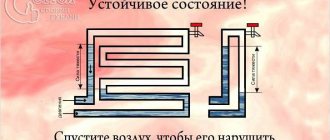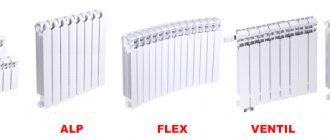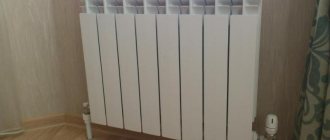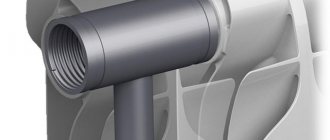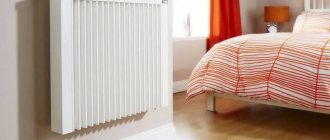Which batteries should you choose?
There are many models of radiators made from various alloys on the modern market. Each has its own positive characteristics and features of use.
Aluminum batteries
Radiators made from this material are produced in two types – cast and extruded. The former are a one-piece monolithic structure, while the latter are made of aluminum parts welded together. Leaf type batteries are more durable and reliable.
Regardless of the type, aluminum radiators have common basic technical characteristics:
- section weight – from 1 to 1.47 kilograms;
- permissible maximum coolant temperature – 110 degrees;
- product power – from 82 to 212 watts;
- the maximum liquid volume of one section is 0.46 liters;
- working pressure – from 6 to 24 atmospheres.
Batteries have been made from aluminum since the eighties. These days, the products have improved quite a bit and have not lost their popularity.
Aluminum batteries
The main advantages of aluminum heating radiators include:
- light weight of the product, facilitating its quick installation and transportation;
- high level of heat transfer due to rapid heating of the metal and the intensity of heat exchange;
- the ability to adjust the temperature even with a small volume of coolant;
- relatively low price for the product;
- good strength;
- decent appearance.
Along with the advantages, aluminum batteries have some disadvantages:
- low resistance to corrosion;
- the possibility of formation of air in the system due to the chemical process.
If we take extruded models into account, we can highlight their weak point - threaded connecting fasteners. With a sharp increase in pressure in the system, the integrity of the structure may be compromised.
Radiators made of steel
The installation of such radiators is justified in private houses with a local autonomous heating system. The peculiarity of devices of this type is:
- working pressure – from 6 to 13 atmospheres;
- The maximum water temperature in the battery is 110 degrees.
Despite their relatively low technical characteristics, steel radiators are very popular. The use of devices has the following advantages:
- compact designs;
- possibility of adjusting the temperature using a thermostat;
- high heat transfer rates;
- a wide variety of models produced;
- the cost is much lower than many new types of batteries being released.
Among the disadvantages, the most significant are:
- incompatibility with an open heating system;
- susceptibility to corrosion;
- special requirements for the quality of the coolant used.
Radiators made of steel
The presence of various chemical impurities in the liquid used in a steel battery can cause destruction of the material. In this case, coolant leakage is sometimes observed due to violations of the tightness of the connections. Therefore, steel radiators are not installed in multi-storey new buildings.
Bimetallic batteries
Radiators of this type are improved models that combine all the advantages of aluminum and steel products. The devices have earned widespread use due to their high technical characteristics:
- maximum internal working pressure – 60 atmospheres;
- heat transfer – up to 190 watts;
- maximum coolant temperature 110 degrees.
There are many advantages of using bimetallic radiators:
- long service life - up to fifty years;
- high thermal output and quick heating of the room;
- good anti-corrosion properties;
- high level of strength;
- possibility of installing additional sections;
- maximum sensitivity to thermostat commands;
- Availability of models with different design solutions.
Bimetallic batteries
The material withstands high hydraulic shocks characteristic of central heating systems.
The disadvantage of bimetallic radiators is their high price. As a rule, they are more expensive than aluminum or steel products. Cheap bimetallic batteries do not have corrosion protection, so over time, rust will form on the product.
Differences between cast iron and bimetallic radiators
As a rule, consumers, when deciding to replace old-style cast iron batteries, study devices made of other metals existing on the market. Currently, analogues made of steel, aluminum and bimetal are on sale, while new generation cast iron batteries are completely ignored, but in vain.
If we consider an alternative to the old “accordions” installed in apartment buildings with central heating, then the most reliable replacement will be batteries made of cast iron and bimetal. There is an explanation for this:
| View | Design | Connection type | Volume | Corrosion resistance | Operating pressure | Building height | Guarantee | Heat dissipation |
| cast iron | sections | lateral | old: 1.5l new: 0.8l | high | 9-12 atm. | 5-6 floors | 10-30 years | 110 W |
| bimetal | sections | side and bottom | 0.25l – 0.4l | high | 25-50atm. | 9 and above | 25 years | 170-200 W |
As can be seen from the table, new-style cast iron radiators, like bimetallic models, may well become a replacement for old devices. The most significant difference between them is the price. Batteries made of cast iron, as before, are much cheaper than their counterparts made of other metals, while bimetal is considered the most expensive in the modern thermal equipment market.
If you need to replace cast iron batteries at minimal cost, then you need to purchase devices made of the same metal and with the same technical parameters. As a rule, such a procedure will not take much time and will not cause much trouble.
Replacing cast-iron heating batteries in an apartment located in a five-story building with bimetallic counterparts is an inappropriate waste of money. Modern cast iron models look no less stylish than aluminum or bimetal ones, and the metal itself has been tested for strength in Soviet heating systems.
How to calculate the number of sections?
In a residential area, the recommended power of heating devices per cubic meter is 100 watts. According to these readings, you can calculate the required number of radiator sections - N. For a collapsible battery, you can use a simple formula:
N=S*100/T
It is taken into account that S is the area of the heated room, and T is the value of the thermal power of one compartment, which can be taken from the passport attached to the product.
More accurate calculations can be made by having coefficients that correspond to data on the characteristics of the room:
- K1 – type of room located above;
- K2 – window features;
- K3 – distance from floor to ceiling;
- K4 – number of window openings;
- K5 – degree of wall insulation.
Taking these indicators into account, you can perform the calculation using the full formula:
N=S* K1*K2*K3*K4*K5*100/T
The thermal power rating is also affected by the battery material. The average value for cast iron radiators is 145 watts; for bimetallic and aluminum radiators this value is slightly higher.
How to paint
If it is not possible to replace old cast iron batteries with more modern heating devices, many people repaint the radiators in the desired color. The entire painting process can be divided into several stages:
- Selection of paint;
- Surface cleaning;
- Paint application;
- Drying the product.
To treat such surfaces, it is recommended to use alkyd dyes, heat-resistant varnish with the addition of bronze or aluminum powder. In addition, for such work you can use water-based paint, to which you can add various pigments to obtain the desired color.
At the initial stage of work, working tools are prepared and the surface of heating devices is cleaned. This can be done using a wire brush, coarse sandpaper or an angle grinder equipped with a special attachment. To facilitate the work, special solutions are used that help destroy the old coating.
The washing liquid is applied to the surface using a brush. After leaving for a certain time indicated on the solvent packaging, the old layer of paint will begin to wrinkle and peel off. The coating can be removed with a small metal spatula. The final cleaning of the battery is carried out using a metal brush.
At the next stage of work, the radiator is thoroughly cleaned with sandpaper and primed, which will help the paint adhere better. The best type of primer is considered to be the GF021 brand; it is suitable for any type of dye.
Next, a layer of paint is applied using a paint brush. The composition is applied carefully from top to bottom. For better coloring, the dye is applied in several layers. In this case, you need to take a break between the stages of applying the coloring composition.
What time of year is best to replace?
In private houses with individual heating, you can change the battery both in the summer and before the start of the heating season. For apartments the conditions are completely different.
If you dismantle the old radiator and install a new one in the summer, you will need information about the presence of water in the system. You can find out from a representative of the housing maintenance office. But at the same time, you need to take into account that you can check the correct installation and quality of heating of the battery only upon the arrival of the heating season.
Why are we not satisfied with old batteries?
When replacing a heating system, you need to draw up a design for a new one, calculate the required number of radiators and shut-off valves. Next, you need to purchase equipment, including a pipeline. All this involves a large investment of money and time. Therefore, owners often ask themselves the question: is it necessary to change the heating at all, are such expenses justified or not?
Firstly, the service life of cast iron batteries is 30-40 years. They have long served their intended life, and if they are not replaced, then one day they will simply leak at the seams. Secondly, old radiators do not fit into the overall interior of modern apartments and houses. And finally, low system performance. There is reason to think about the ever-increasing energy prices.
Battery replacement technology
Quite often, owners decide to replace an old cast-iron battery with a new, more modern and efficient model. Quite often, specialists are called in for this and quickly cope with the task. But since the process of dismantling and installing the radiator itself is not particularly difficult, you can do all the work yourself.
Tools and materials
To replace the battery you need the following equipment:
- special lever wrench for pipes;
- pencil;
- Bulgarian;
- level;
- hammer.
To replace cast iron batteries, do not forget the grinder.
Also, materials are used to install the new device;
- brackets;
- battery;
- taps;
- dowels
Heating element for cast iron battery
A heating element mounted in a cast iron radiator allows you to warm up the room when it is not possible to start the heating system in the usual way. The heating element itself is nothing more than a metal pipe with a spiral sealed in the middle. When installing a heating element in a cast iron radiator, you can achieve optimal temperature values in a small room: garage, kitchen, greenhouse or any other outbuilding.
Heating element for radiator
The main advantages of electric heating elements:
- Possibility of installation in a battery made of cast iron and other materials;
- Automatic control of water heating temperature;
- Using a heater as the main heat source;
- Easy to install.
Anyone can install the described device. The heating elements are equipped with temperature control mechanisms and overload protection. The heater just needs to be installed in the radiator socket and connected to a power source. Before operating the heating element, the heating system must be completely filled with water or another type of coolant.
The heater in the radiator must be in a horizontal position. It usually works in two modes. If the device is used in the system as the main heating source, then the room will warm up to the set temperature, and a special thermostat will maintain the temperature at the specified parameters.
Connection to a cast iron battery
If the heating element is used in a country house or in an auxiliary room, then the main task of the heater will be considered to be minimal heating of the system to protect against freezing. In this case, the device is set to minimum power.
How to rinse at home
In country houses, the heating system often loses its efficiency. This happens through poor heat transfer, as well as as a result of debris settling on the walls of the batteries. The coolant heated to a high temperature affects the inside of the radiators, where scale and rust settle. The presence of blockages leads to poor heating of the building.
The main reasons for flushing batteries are:
- Uneven heating of the radiator over the entire plane, when the upper part of the sections is hot, but the bottom of the tank remains cold;
- Warming up the heating system to the required temperature takes longer than usual;
- Increased fuel consumption.
To independently flush heating devices, aluminum or cast iron radiators, you need to drain the water and unscrew the radiator from the system. Removing blockages or flushing occurs using clean water with the addition of acetic acid, special cleaning agents or caustic soda.
Battery before and after washing
It is advisable to carry out the work in the bathroom to prevent liquid from spilling onto the floor. At the same time, a mesh is installed in the bathroom drain hole to collect large contaminants. Pre-placed rags will help prevent damage to the container's coating.
At the initial stage of work in cast iron radiators, all plugs are unscrewed, and water heated to a boil is poured into the resulting holes. Next, shake out the heating device and drain the liquid and debris.
Next time, water with the selected cleaning agent is poured into the radiator. After this, close all the plugs, knock on the device with a wooden hammer, shake it and pour out the water. Similar operations are carried out until clean liquid flows from the holes.

